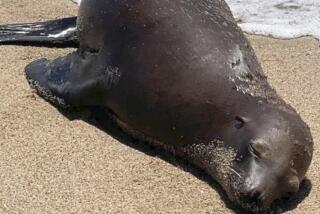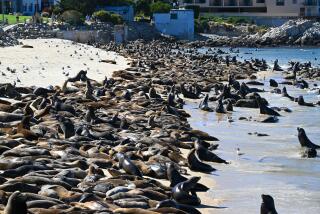Rescued sea lions flooding in
SAN FRANCISCO — The sea lion was lying on a rock near the shore at Crissy Field, looking exhausted. A green fishing lure stuck out of its bottom lip, and a row of ribs showed when it breathed.
It didn’t put up a fight when two volunteers from the Marine Mammal Center in Sausalito approached it from behind and threw a net over its head. The volunteers nudged the sea lion into a dog kennel, carried it off the rocks and took it to Sausalito for treatment.
The center, which has at least three volunteers on call every day, has struggled to keep up with the number of distressed sea lions in the Bay Area.
Most are malnourished, some are injured. It has taken in almost three times as many as usual for this point in the year, said center spokesman Jim Oswald. On Monday, it was housing 93.
It’s not alone. Most rescue centers on California’s coast are treating a record number of sea lions this summer.
“We’re loaded with sea lions right now,” said Dr. Richard Evans, medical director of the Pacific Marine Mammal Center in Laguna Beach. “Normally, we spend $30,000 on food per year. This year, we’ve already spent $48,000.”
The distressed animals generally fit the same profile. They’re young sea lions who can’t find enough food in waters where squid, anchovies and sardines are usually plentiful. They climb out of the ocean, exhausted. Volunteer crews find them stranded on beaches and piers, and occasionally wandering on the freeway.
Marjorie Boor, who has rescued more than 100 sea lions in her four years as a volunteer, recently helped save one on Interstate 880 in Oakland just before morning rush hour traffic began.
“The policeman opened the cruiser, and he jumped right in,” she said. “It could have been a disaster.”
Scientists think El Nino could be responsible. The El Nino weather pattern brings warm water currents to the California coast about every five years.
Fish follow colder currents farther out into the ocean, depleting the sea lions’ food supply near the coast. Young sea lions tend to be more affected because they are not experienced hunters.
Scientists on Thursday announced the arrival of El Nino in the tropical Pacific Ocean, but a complete transition has not occurred off California, said Joe Cordaro, a biologist with the National Marine Fisheries Service.
El Nino conditions usually last for about 12 months, he said.
Water temperatures have increased since the end of May, a change that coincided with an increase in sea lion deaths, said Bill Sydeman, president and senior scientist with the Farallon Institute.
“We’re due for a strong one,” he said. “It looks like an El Nino is brewing, and the effects will depend on how much it spreads.”
The last severe El Nino was in 1998. About 3,000 sea lions were stranded that year, twice the normal number. If the state experiences a severe El Nino, a large number of sea lions and other marine animals could starve during the next year.
However, the recent increase in stranded sea lions is not threatening the entire population. There are 250,000 California sea lions in the state, and the population is considered healthy.
Marine rescue centers try to save as many animals as possible for humane reasons and for research. Scientists who study endangered marine mammals benefit from looking at tissue samples from the California sea lion, said Jeff Boehm, executive director of the Marine Mammal Center. The center keeps 20 years’ worth of samples and has dealt with an assortment of disorders and diseases.
The centers try to save every sea lion because people connect emotionally with them, Boehm said. People often call rescue centers, upset because they see a hurt animal, and stay with the animal until help arrives.
“We’re inundated with animals,” Boor said. “But people get upset if they aren’t taken almost immediately.”
Crowds gathered at Crissy Field on July 1 to watch the rescue of two sea lions. Both were taken to the center in Sausalito and placed in pens.
Operations Manager Deb Wickham tended to the sea lion with the fish hook in its mouth, now called Taiko.
She cut the lure with wire cutters and said the animal would have to be sedated before the rest of it could be removed. Afterward, staff members would feed it fluids and ground fish, she said.
About half of the center’s sea lions survive and are released back into the ocean.
“His ribs are showing, but some come in a lot skinnier,” Wickham said. “It’s hard to tell which ones will make it.”
--
More to Read
Sign up for Essential California
The most important California stories and recommendations in your inbox every morning.
You may occasionally receive promotional content from the Los Angeles Times.










